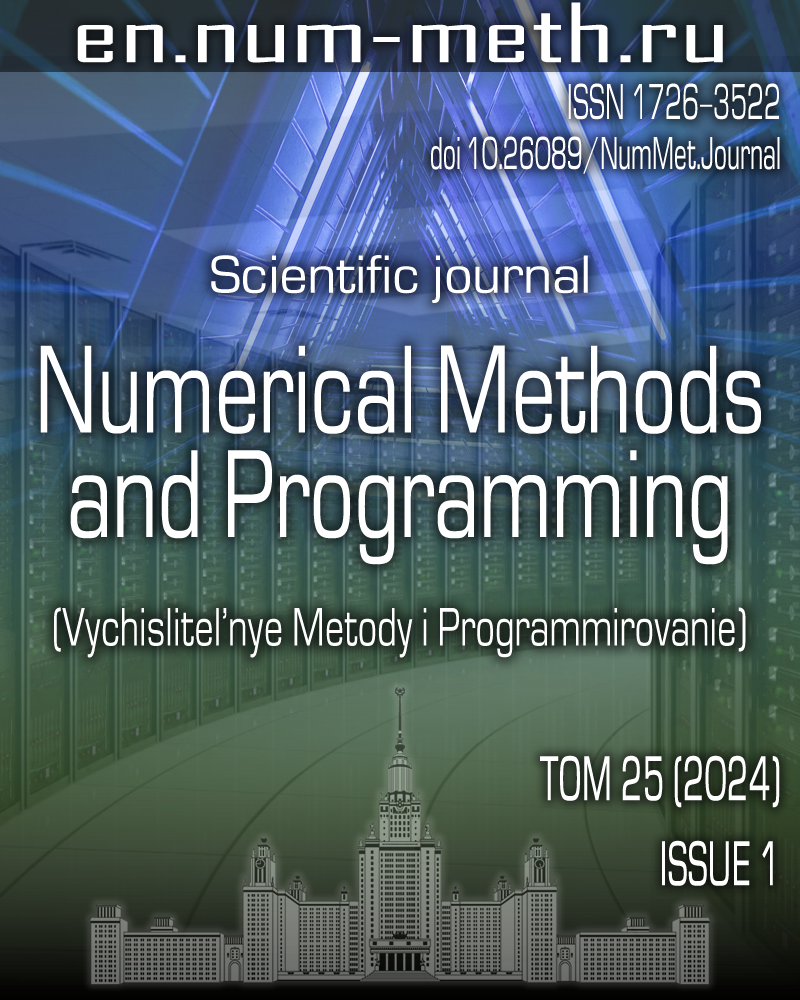DOI: https://doi.org/10.26089/NumMet.v25r101
Computational algorithm for the continuation of potential fields towards gravitating masses
Keywords:
Abstract
The continuation of potential fields from the Earth’s surface into the depths is the most important problem in gravity exploration. Based on the solution of such a problem, the location of gravity field anomalies is identified. The solution of the integral equation of the first kind with the application of some regularization procedures is often used for the approximate solution of the problem of the continuation of potential fields. A similar approach is used in our work when the continued field is represented as a simple layer potential or its vertical derivative. The density of the equivalent simple layer potential is positive (negative) for positive (negative) density anomalies, provided that the surface of the equivalent simple layer potential contains all of the anomalies. The consideration of this property is a key feature of the proposed calculation algorithm for continuation of potential fields with respect to anomalies. The determination of the non-negative density of the simple layer potential is based on the NNLS (Non-Negative Least Squares) method. The efficiency of the developed computational algorithm is illustrated by calculating two-dimensional problems.
Published
Issue
Section
References
- E. A. Mudretsova and K. E. Veselov (Eds.), Gravimetry: A Handbook in Geophysics (Nedra, Moscow, 1990) [in Russian].
- Yu. I. Blokh, Interpretation of Gravitational and Magnetic Anomalies (MGGA, Moscow, 2009) [in Russian].
- A. G. Yagola, V. Yanfei, I. E. Stepanova, and V. N. Titarenko, Inverse Problems and Methods of Their Solution. Applications to Geophysics (Binom, Moscow, 2014) [in Russian].
- A. S. Dolgal, Gravimetry and Magnetometry: Transformations of Geopotential Fields (PGNIU, Perm, 2022) [in Russian].
- M. M. Lavrentiev and L. Ya. Savelyev, Theory of Operators and Ill-Posed Problems (Institute of Mathematics, Novosibirsk, 2010) [in Russian].
- A. N. Tikhonov and V. Ya. Arsenin, Solutions of Ill-Posed Problems (Nauka, Moscow, 1974; Wiley, New York, 1977).
- S. I. Kabanikhin, Inverse and Ill-Posed Problems: Theory and Applications (De Gruyter, Berlin, 2011).
- A. A. Samarskii and P. N. Vabishchevich, Numerical Methods for Solving Inverse Problems of Mathematical Physics (De Gruyter, Berlin, 2007).
- A. F. Verlan’ and V. S. Sizikov, Integral Equations: Methods, Algorithms, and Programs. Reference Book (Naukova Dumka, Kiev, 1986) [in Russian].
- A. N. Tikhonov, V. B. Glasko, O. K. Litvinenko, and V. R. Melikhov, “On the Continuation of the Potential toward Perturbing Masses in Gravimetric and Magnetic Reconnaissance on the Basis of the Regularization Method,” Izv. Akad. Nauk SSSR, Fiz. Zemli, No. 2. 30-48 (1968).
- A. N. Tikhonov, A. V. Goncharsky, V. V. Stepanov, and A. G. Yagola, Numerical Methods for the Solution of Ill-Posed Problems (Nauka, Moscow, 1990; Kluwer, Dordrecht, 1995).
- C. L. Lawson and R. J. Hanson, Solving Least Squares Problems (SIAM Press, Philadelphia, 1995).
- P. N. Vabishchevich and P. A. Pulatov, “Economical Difference Methods for Solving Direct Problems of Gravi- and Magnetosurvey,” Izv. Akad. Nauk SSSR, Fiz. Zemli, No. 10. 68-76 (1983).
- A. A. Björck, Numerical Methods for Least Squares Problems (SIAM Press, Philadelphia, 1996).
- Fundamental algorithms for scientific computing in Python.
https://scipy.org/.Cited January 10, 2024.
License
Copyright (c) 2024 П. Н. Вабищевич

This work is licensed under a Creative Commons Attribution 4.0 International License.


